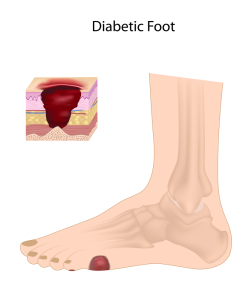Introduction
Treatment of diabetic neuropathy consists of tight control of the hemoglobin A1C level combined with a diet change where refined carbs (sugar, starchy foods) are cut out an replaced with complex carbs (vegetables, salads). In addition physical exercise needs to be increased and oral diabetic medications and/or insulin therapy likely have to be instituted.
Gabapentin
The pain can be directly treated with gabapentin (brand name: Neurontin). This medication, which was approved by the FDA in the early 1990’s for resistant partial epilepsy, has also been found useful for chronic pain issues such as neuropathic pain following trauma, shingles pain and diabetic neuropathy pain.
The advantage of this medication is that it is not metabolized by the liver and that it is mostly excreted by the kidneys. This way there is no drug interaction with other drugs and the side effect profile is very safe. More than 90% of patients tolerate this medication at high doses like 3600 mg per day. Usually the medication is started low at 300 to 600 mg per day and slowly increased (titrated) with regard to the response in treating the pain symptoms, if tolerated. It can be combined with low doses of anti-depressants, which often allows the physician to reduce both the Neurontin and the anti-depressant doses and still treat the pain effectively. Side effects include tiredness (15%) and dizziness (11%). Even very high doses taken with suicidal intentions did not lead to deaths making it one of the safest drugs. Dr. Stephen Clarke, Clinical Assistant Professor in the Div. of Neurology of the University of BC/Vancouver/Canada, reviewed the use of gabapentin at a conference in Vancouver/BC (Ref. 10).
He said that it is a “widely loved drug” because of the perceived safety and tolerability. The mechanism of action, he summed up, is an increase of the relaxing brain hormone, called gamma amino butyric acid (=GABA neurotransmitter), in some brain regions. It also inhibits N-methyl-D-aspartate (the NMDA receptor) and calcium channel blockers in the brain, the spinal cord and in nerves in the body. The NMDA receptor is important in perception of pain and transmitting pain through the spinal cord pathways. Neurontin inhibits the transmission of these pain stimuli and dampens pain perception. This is called a “pain modulating” effect. It takes only 38 patients to treat to get a 50% decrease of the pain score in 10 patients, in other words the “number needed to treat” (or NNT) is only 3.8, which in the evidence based literature is considered a good drug. Ask your physician about more details.
References:
1. MT Kailasam et al. J Hypertens 2000 Nov 18(11): 1611-1620.
2. G Chinetti et al. Inflamm Res 2000 Oct 49(10): 497-505.
3. St. Paul’s 46th Annual Cont. Med. Educ. Course for Prim. Phys., Nov. 14-17, 2000. Dr. David Thompson, Div. of Endocr., Vancouver Hosp. and UBC.
4. B J Goldstein Int J Int Pract 2000 Jun 54(5): 333- 337.
5. M Maghnie et al. N Engl J Med 2000 Oct 5;343(14): 998-1007.
6. E Albertazzi et al. J Am Soc Nephrol 2000 Jun 11(6):1033-1043.
7. M Funk et al. American Journal of Emergency Medicine Vol.19,No.6, Oct.2001, W. B. Saunders Company
8. Ferri: Ferri’s Clinical Advisor: Instant Diagnosis and Treatment, 2004 ed., Copyright © 2004 Mosby, Inc.
9. Rakel: Conn’s Current Therapy 2004, 56th ed., Copyright © 2004 Elsevier
10. The 50th Annual St. Paul’s Hospital Continuing Medical Education Conference for Primary Physicians, Nov. 16 – 19, 2004







